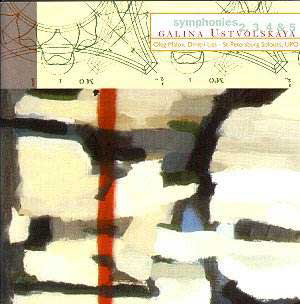All but the First of Ustvolskaya’s symphonies have
a religious subtitle although the composer always firmly emphasised
that these works were in no way to be experienced as religious works.
Moreover, Ustvolskaya chose some texts which she found in an anthology
of medieval Latin literature published in Moscow in 1972. She appears
to have been drawn by the writings of a Benedictine monk, Hermanus Contractus
von Reichenau, who was renowned for his wide-ranging knowledge in many
fields, ranging from mathematics and astronomy to pietistic poetry and
music. But – as will be seen later – this has very little relevance,
if any, to the actual content of the symphonies.
The Symphony No.2 "True and Eternal Bliss",
completed in 1979, is scored for voice and orchestra, but the layout
of the orchestral forces is quite unusual: 6 flutes, 6 oboes, 6 trumpets,
trombone, tuba, piano and percussion. The vocal part, if such there
really is, sets just three isolated words ("Lord", "Eternity"
and "Truth") repeated in a rather bland manner at various
stages in the course of the work.
The Symphony No.3 "Jesus Messiah, Save Us",
completed in 1983, is also for voice and orchestra (this time, 5 oboes,
trumpets, double basses, 3 tubas, trombone, piano and percussion). It
sets an astonishingly banal prayer of little religious meaning.
In the Symphony No.4 "Prayer"
of 1985/7, the instrumental forces are pared down to a bare minimum:
contralto (should be dressed in black and must not wear any jewels,
dixit the composer), trumpet, piano and percussion (i.e. a large-size
wooden cube hit with a hammer). The contralto sings (or rather declaims)
the same banal text already used in the preceding symphony. This short,
monolithic works plays for a little over six minutes!
The last symphony, Symphony No.5 "Amen",
was composed in 1990. It is scored for very limited forces again : oboe,
trumpet, tuba, violin, percussion (i.e. a wooden cube) and narrator.
The text (actually The Lord’s Prayer) is merely declaimed throughout
the work.
These works have much in common: religious subtitles
though with little religious intent; texts of little theological or
philosophical relevance; unusual orchestral layout. Moreover, they all
share the same ritualistic character achieved by relentless repetition
of often massive sound blocks hammered-out fortissimo throughout.
As Frans Lemaire rightly observes in his excellent notes, the music
abounds in crescendos, but there are no decrescendos whatsoever.
The music is abruptly cut short before regaining dynamic volume. The
music is bleak, pessimistic from first to last, with little relief and
with no final consolation. "The listeners ... will only find the
plaintive sighs of terror and pain" (Frans Lemaire). Religious
music, you said?
These utterly idiosyncratic works are given carefully
prepared and committed readings, well recorded and well produced. Again,
excellent notes by Frans Lemaire.
Ustvolskaya’s music is like nothing else; and there
is no denying the almost visceral intensity of her "rituals of
despair".
Hubert Culot


